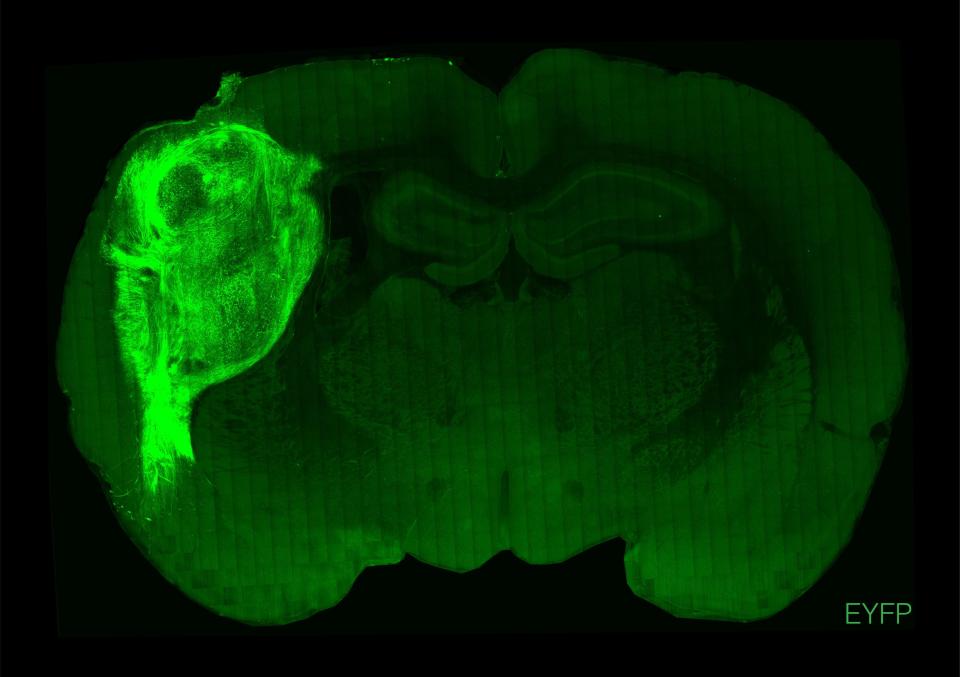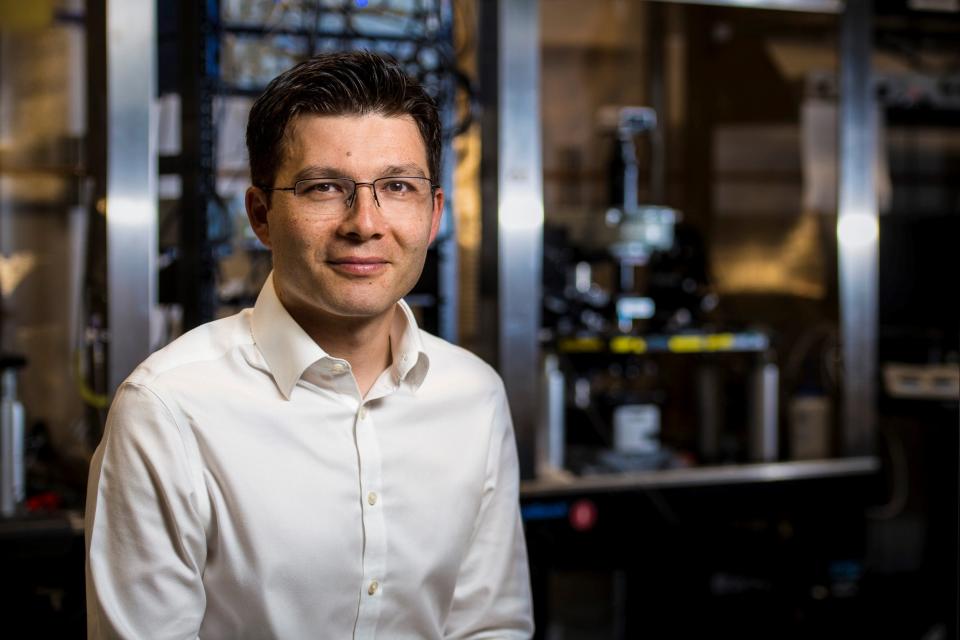These rats have human cells in their brains. They may help scientists understand autism and schizophrenia.
In Dr. Sergiu Pașca's research lab at Stanford University, the resident rats have clumps of human cells in their brains.
Blow on a rat's whiskers and the human cells on the opposite side of its brain light up. Teach a rat that it can get water from a spigot only when its human cells are activated and it will learn how in about two weeks – it's proof, Pașca said, that the human cells have integrated into its brain and are performing an important function.
His experiments, published Wednesday in the journal Nature, are both significant and ethically challenging.
Pașca, a professor of psychiatry and behavioral sciences, believes his work eventually will help scientists better understand the psychiatric conditions that plague more people worldwide than any other health issue.
Brain conditions such as autism and schizophrenia do not naturally occur in rodents, and scans don't reveal enough about human brain cells in action, so they aren't well understood or treated.
"The human brain has certainly not been very accessible, which has precluded the progress," Pașca said in a news conference Monday. "Building human models that are not invasive of the human brain is one of the most promising avenues in trying to tackle these conditions."

Bioethicist Insoo Hyun said he isn't concerned about Pașca's own research but worries what other scientists will do with the advances he's making.
At Stanford, Pașca is following strict protocols and his work is monitored by an animal welfare committee, but other scientists might not adhere to the same rules, interpret them differently or take the work in unethical directions.
"With some of these big advances come risk in how people use them," said Hyun, who directs the Center for Life Sciences and Public Learning at the Museum of Science in Boston. "If you have an advance for one purpose, you cannot necessarily prevent other people from using that same advance to do something else that the founder of that technology would not approve of. That's across the board for any type of technology."
SOME PEOPLE WITH AUTISM FINALLY FEEL SEEN: Here's why.
WATCH: Study helps those with autism improve driving
Madeline Lancaster, a developmental biologist who studies conditions like autism, said she's not worried about "humanizing" the rats, because the transplants are small and lack typical brain organization.
Instead, Lancaster, who works at the MRC Laboratory of Molecular Biology in Cambridge, England, sees Pașca's research as overcoming some of the limitations of previous studies.
"I see this as a model to investigate human neuronal maturation on a single neuron or group of neuron level, but these are not actual brain tissues being implanted and so there are minimal concerns around their potential for higher cognitive functions," she said via email.
In his research, Pașca inserts clumps of human brain cells – he calls them organoids or assembloids – into a rat brain. About one-third of the mouse cortex consists of human cells.
By using cells from typical brains in some rats and cells from people with brain conditions into others, he can see what's different.
He started with a disease called Timothy syndrome, which can cause fatal heart rhythm disturbances as well as webbed fingers and toes, epilepsy and the impaired communication and socialization skills of autism spectrum disorder.
Rats with brain organoids made from someone with Timothy syndrome are shorter and make abnormal connections compared with those made from someone without the condition – differences that hadn't been seen in a dish. Pașca hopes these Timothy syndrome rats can be used to better understand what happens in the brains of people with the condition and to test drugs on these brains to try to reverse problems.
CAN YOU IMPROVE MEMORY? Brain stimulation could make a 'moderate to large' difference, study shows.
He's now working on models of other genetic neurodevelopmental conditions, such as other types of autism and schizophrenia. Though he's focused on conditions that are genetically triggered, Pașca said, the work can also be used to look at certain environmental contributors by exposing the rats to pollutants or social stress.
Hyun said he was startled that the rats with human brain assembloids seemed to behave like typical rats, lived a normal lifespan and didn't suffer seizures. They also didn't show any extra or human-like intelligence.
Experts would have predicted one outcome or the other, but "the human cells integrated seamlessly, which was really surprising," said Hyun who filmed an extended interview with Pașca talking about the ethics of the research.

Pașca's key advance was to transplant the human brain cells after the rat was born, but very early in its life. "That's a good tip for people to follow," Hyun said.
Pașca started his research shortly after it became clear that adult skin and blood cells could be transformed back into embryo-like, multipurpose stem cells. He was among the first to make brain cells from adults with conditions like autism and schizophrenia – without needing access to their brains.
But studying brains in a dish had limitations, he said. In a living brain, cells inhabit three dimensions, not two, and grow connections with their neighbors as well as distant other cells.
So, Pașca began building organoids and then assembloids, three-dimensional combinations of cells and then groups of cells to watch them interact. These were useful in examining some functions of the cells but lacked the blood supply needed to grow larger and didn't help explain the behaviors that define conditions like schizophrenia and autism.
For the past seven years, he has been working to transplant these organoids into a living mouse brain to begin exploring how cell activities affect behavior.
The human brain organoids transplanted into living rats grow neurons that are as much as six times larger than those grown in lab dishes. Their length and their electrical activity much more closely resemble neurons in the human body.
CAN GENE SEQUENCING AT BIRTH PREVENT TERRIBLE DISEASES? Researchers hope so.
"You can now discover defects that you would not be able to see in a dish," Pașca said.
But these modified rats still have limitations as models for human disease.
Human brain cells, even when implanted into a newborn rat, still develop at a human pace, not a rat's. A rat cortex is made in one week, a human's in 20, so the animal is fully mature while the human cells are still relatively in their infancy.
Researchers could try the same approach of implanting human cells into a primate, whose pace of development is much more similar. But Pașca is not comfortable with the ethics of that.
"Transplantation into primates is not something I would encourage doing," he said.
The different pace is also what keeps the rat from becoming human-like, Pașca said. Only one side of the rat brain has human cells in it, so it doesn't start taking on human attributes, the way a primate might.
Plus, there's plenty to learn just from the work in rats, he said.
Already, he hopes to understand more about the functioning of the human brain, both typically and in the presence of genetic flukes, about evolution, disease, and how drugs affect the function of cells.
"It's going to be really interesting to see where things go next," Hyun said.
Contact Weintraub at kweintraub@usatoday.com
Health and patient safety coverage at USA TODAY is made possible in part by a grant from the Masimo Foundation for Ethics, Innovation and Competition in Healthcare. The Masimo Foundation does not provide editorial input.
This article originally appeared on USA TODAY: These Stanford lab rats have human cells in their brains. Here's why.

